- Home
- Tom Clancy
Battle Ready sic-4 Page 2
Battle Ready sic-4 Read online
Page 2
On November 14, in the face of the Iraqi demand to remove the Americans, Butler evacuated the entire contingent of inspectors; but after several days of intense diplomatic activity, they were all able to return — though, once again, with less freedom to operate than before. Every “diplomatic solution” lessened UNSCOM’s ability to get the disarmament job done.
Meanwhile, the Iraqi lies and threats did not stop; and over the next months, Saddam raised the stakes again and again — always probing for weaknesses, always trying to limit UNSCOM’s effectiveness.
In response, CENTCOM built up forces in the region to be ready to strike if the inspectors were no longer able to do their business. This operation became known as “Desert Thunder.”
In February, Secretary of Defense Cohen and Zinni conducted a four-day trip to eleven countries to gain support for a major air strike if Butler’s inspectors were unable to carry out their mission. By February 17, when a confrontation with Saddam seemed imminent, President Clinton announced in a televised speech that the U.S. would act if he did not cooperate with the inspectors. Zinni briefed the President and key cabinet members on the planned strike and defense of American allies in the region.
But once again Saddam made a last-minute retreat. A February 20 visit to Baghdad by UN Secretary-General Kofi Annan got an agreement from Saddam to resume cooperation with Butler; yet it was clearly only a matter of time before this cooperation would collapse.
Meanwhile, the U.S. forces that had been added to the units already in the region remained in the Gulf, poised to strike.
During the target selection process for Desert Thunder, the President had injected a new and unprecedented element into the planning — he had clearly begun seriously to face the question raised by the likelihood that Saddam would finally block UNSCOM’s work. “Can we militarily eliminate Saddam’s weapons of mass destruction program?” the President asked Zinni. Previous air strikes had simply punished the Iraqis in the hope of forcing their cooperation. Now he was asking whether bombing could accomplish militarily what the inspectors seemed no longer able to do on the ground.
Zinni’s answer at that point was negative. “We don’t know enough about the WMD program,” he said, “much less where the components of the program are. That’s why the inspectors are in there.”
But Clinton persisted. “What can be done militarily about the WMD?” he kept asking. “To what level can we take them out?”
As time went on, Zinni began to come up with answers.
Once they are built, WMD are relatively easy to hide. But the facilities and processes that are used to build them are much harder to conceal. Zinni’s people knew quite a lot about these. The delivery systems and the fuels that powered them were vulnerable, as were the security systems and personnel that protected the programs; the various documents, information, materials, and the research-and-development operations; and the special and difficult-to-acquire machinery required to fabricate high-tolerance parts (such as centrifuges needed to separate fissile uranium from its more stable forms).
Whenever an air strike was imminent (normally tipped off by a buildup of CENTCOM forces in the region as tensions mounted), the Iraqis would move the more vulnerable elements of their WMD programs out of harm’s way. These were the elements that could be taken out… if they could be hit before they’d been moved to safety.
“The Iraqis are allowed to have certain missiles,” Zinni reported to the President. “But within that capability, they can research and develop an expanded capability, which at some point can be turned into a delivery system. We can eliminate that. We can bomb their missile facility.
“They also have experimental, developmental programs on fuel for missiles and rockets. We can take these out.
“We know the security forces charged with protecting WMD program information, documents, materials, and R & D studies. The Special Republican Guard is charged with these missions. We can hit them.
“We know the facilities where they keep high-tolerance machinery that is necessary for a nuclear program. We can hit those facilities.
“And we can add targets vital to the regime, like their intelligence headquarters and the Ba’ath party headquarters. Taking out such targets will do serious damage to their command and control capabilities.
“Taking out all these things will not end forever their WMD program,” Zinni said in conclusion. “If the strike goes well, if we are really lucky, the best we can do is set back their programs for two years. It will take about that much time to reconstitute and replace what we’ve destroyed.”
With the President’s approval, Zinni was given the go-ahead to plan for striking these targets.
DESERT VIPER
Butler and his UNSCOM inspectors soldiered on, but with ever-increasing difficulties. From May 1998 to the end of that year was a time of almost constant crisis.
Though UNSCOM was intended to be a verifying and not an investigative body, the Iraqi obstacles to its proper functioning had required the creation of an investigative and forensic unit. In June 1998, the UNSCOM investigations discovered long-sought smoking guns — stores of Scud-specific propellants and incontrovertible evidence of VX production (one of the most vicious of the nerve agents[4]).
Because the propellants could be used only for Scuds, there was no reason for the Iraqis to have kept the stuff around—if, as they had long claimed, they had destroyed all their Scuds.
The Iraqis were later proved to have produced close to four thousand liters of VX long ago — after claiming far lower estimates. “But of course,” they told UNSCOM, “we’ve destroyed all that we made during the years they had actually made the stuff.”
The UN resolution demanded UNSCOM verification, but the Iraqis always blocked UNSCOM from verifying anything significant.
Naturally, UNSCOM successes did not sit well with the Iraqis.
On August 5, the battle entered its final phase, when the Iraqis officially suspended UNSCOM’s disarmament work. Though Kofi Annan and others shuttled to all the usual capitals in an effort to attain another “diplomatic solution,” by October 31 no one serious doubted that the work of UNSCOM was finished. No one knew how the end would come — whether the Iraqis would throw the inspectors out, or the inspectors would give up and walk out — but one way or another it was certain that the UNSCOM operation in Iraq was untenable.
When that happened, the heavy air strike would inevitably follow.
As that moment approached, Secretary of Defense Cohen, communicating through General Hugh Shelton, the chairman of the Joint Chiefs of Staff, directed Zinni to prepare two attack plans — a heavy option, and a lighter one. The heavy option would attack many targets over several days. The lighter option would be shorter, and hit fewer targets.
Though he could have lived with either option, Zinni preferred the heavier. “If you’re going to hit him, hit him,” he told the Joint Chiefs.
On the seventh of November, he flew up to Washington to brief the plan.
If he thought the briefings would be easy, and followed by an automatic approval of his plan, he was wrong.
A briefing with the Joint Chiefs was held in the small Pentagon conference room called “the Tank.” When Zinni had finished, the chairman called for a vote on the options.
To say that the vote surprised Zinni was an understatement; the vote itself made no sense. Not only was there no serious discussion beforehand, nor to his knowledge had there been earlier sessions to discuss the options, but, most important, the Joint Chiefs were not in Zinni’s chain of command (which went directly through the Secretary of Defense to the President). The CINCs are operationally independent of the Joint Chiefs, whose primary job, in their Service Chief role, was to provide the CINCs with the personnel and equipment they needed to do their job. In other words, to Zinni the vote was meaningless (though no CINC casually ignores the recommendations that the JCS gives on employment of U.S. forces). He was even more shocked when the JCS voted 4 to 2 for the lighter
option, after he had recommended the heavier one. Since there had been little discussion before the vote, the reasons for their choice were unclear. Whatever the reason, Zinni could sense their nervousness: Going against the CINC’s recommendation made them all uneasy. None of them liked to second-guess a field commander.
Though Zinni repeated that he could live with either option, his difference with the Chiefs remained. Since the place to resolve their difference was higher up, General Shelton recommended to Secretary Cohen that Zinni attend a meeting of the principal cabinet members and the President at Camp David in order to discuss the options.
The next day, November 8, he flew out to Camp David.
The meeting was held in the wood-paneled conference room of the main cabin. Bill Clinton, seated at the head of the table, was flanked by the Director of Central Intelligence, George Tenet; the Secretary of State, Madeleine Albright; the Secretary of Defense, Bill Cohen; the National Security Adviser, Sandy Berger; and the JCS chairman and vice-chairman, Generals Shelton and Ralston. Though the Vice President was not present, he was on a speakerphone.
As the group discussed the choices, Zinni sensed that the cabinet was as divided as the Joint Chiefs; and when it came time for a vote, there was again no consensus. The Secretary of State leaned toward the heavier strike, the Secretary of Defense the lighter, George Tenet the heavier, and so on around the table. The cabinet members were all over the map.
It was left to Sandy Berger to square this circle.
“Are these two options mutually exclusive?” he asked reasonably. “Why couldn’t we start with the lighter one and see how it goes, but hold open the option of going heavy?”
“That’s fine with me,” Zinni answered. This was neither the time nor the place for drawing a line in the sand. At this stage, he just wanted to get on with it. “I’m not trying to make this hard. If that’s what you want, we’ll work it that way.”
The President approved the compromise.
The trigger for Desert Viper was to be the end of the inspections. As soon as Richard Butler announced, “We’ve had it; we’re out of here; we can’t do business,” the clock would start ticking. The bombs would start dropping within hours.
Preparing for this takes time. Bringing bombs to their targets is an enormously complex process, involving land-based aircraft, carrier aircraft, and cruise missiles fired from both ships and B-52s. The various strike aircraft have to be in the air — along with tankers, the Airborne Warning and Control System (AWACS), and all the other support aircraft; the ships and carriers have to be in position for launch; the crews must all have their required rest; and much, much more. Zinni’s people needed about twenty-four hours before the actual strike in order to make all that happen.
At some moment after the inspectors climbed into their white UN SUVs, drove out to Habbaniyah Air Base[5] eighty-five miles northwest of Baghdad, and took a plane to Bahrain — or some other friendly place — the President had to give the “go” decision for Desert Viper. Twenty-four hours later, the bombs would fall.
Once the twenty-four hours started, the strike could be stopped at any time up to six hours before the scheduled impact. But six hours was the drop-dead moment. That was when the first cruise missiles were launched.
This fact had caused some controversy — Clinton’s advisers didn’t want to tell the President what he couldn’t do.
“You don’t understand,” Zinni told them. “When you get beyond six hours, the launch is a done deal. Nobody can stop it.”
“But you can’t tell the President that,” they replied. “He has to be able to call back his decision up to the last moment.”
“I’ve got no problem with that,” Zinni persisted. “What I’m telling you is that the last moment is six hours before the bombs drop. And you need to tell him he can’t.”
The controversy came to a head at a Pentagon session, attended by the President. Zinni had with him what was called “the Master Air Attack Plan”—an enormous and labyrinthine time/event matrix that came rolled, like a scroll.
When the advisers began to sense that Zinni intended to show the plan to their boss, they were horrified: “You can’t do that! It’s too complex!”
But when the opportunity came, Zinni unrolled the plan on the conference table. “Mr. President,” he said, “you need to see all the moving parts that have to be in position and all the timelines and limits we’re working from. You need to see when you have to make the decision to start. And you need to see exactly what’s happening with the cruise missiles. They spin up and launch six hours before the strike. Once launched, that’s it. They’re going to go until they hit what they’re aimed at.
“This is the absolute drop-dead time. If you want to send us a no-go, you have to do it before that.”
The advisers’ fears were of course groundless. Zinni knew from previous briefings that Clinton was a very quick study; he instantly caught what Zinni was trying to show him.
“Right,” he said. “Fine, you’ll get the decisions you need in time.”
As November wound on, Zinni’s people kept tabs on the inspectors… watched their progress — or lack of it — waiting for the launch trigger. It came in mid-November. The inspectors had continued to demand access and cooperation, which the Iraqis continued to refuse to give.
As this drama unfolded, CENTCOM built up air and naval forces in the Gulf in preparation for the strike.
Finally, on November 11, the inspectors gave up on the fiction of Iraqi cooperation. They’d had enough. Butler ordered the evacuation of his team; and the President ordered the execution of Desert Viper on the heels of their departure…
… and on November 12, Tony Zinni, in his command room in Tampa, with his fudge time completely gone, grabbed a phone and called Willy Moore, hoping against hope that Admiral Moore could stop the Tomahawks anyway.
The admiral said: “You may be in luck, sir. I built in fifteen minutes of fudge time myself. But we’re already into it.” Moore scrambled. He had to get word out to all eight ships to shut down the missiles — by then their gyros were already spinning, the last step before they are launched.
And with exactly eight minutes left until the launch — he succeeded. Meanwhile, Zinni got the planes in the air recalled. Desert Viper was averted. But it achieved its aims: Saddam had blinked once again. Richard Butler’s inspectors flew back into Habbaniyah and attempted to resume their work.
DESERT FOX
One aspect of their (temporary) success troubled Zinni and other senior American leaders, though. A few days after Desert Viper was aborted, General Shelton called Zinni to talk about this frustration. “You know,” he said, “every time we deploy forces out there, Saddam sees them coming and moves his sensitive equipment and files out of targeted facilities.”
“You’re right,” Zinni answered, “and because he knows about our precision bombing and concern for collateral damage, he doesn’t have to move it very far.”
“What we need to do,” Shelton continued, “is catch him with these things in place. If we can hit him without any warning, we can do a lot more damage.”
Zinni agreed.
“We need to do something that outsmarts him,” Shelton went on, “something that outfoxes him.” He laughed: “We ought to call the next strike ‘Desert Fox.’ ”
“Yeah,” Zinni laughed with him. But both generals were deadly serious.
“Really,” Shelton continued, “what that amounts to is this: We’ve got to set up the next strike with forces already in the theater, so he doesn’t see any buildup. Or if we have to build up, we do it quietly, or trickle it in bit by bit.
“So here’s my question: Can we do a strike with forces we have in theater, and with maximum operational security and limited numbers of people in on the planning?”
“Let me look at it,” Zinni said. “I’ll see what we can do, and I’ll get back to you.”
The answer Zinni came up with was “Yes”; and General Shelton’s suggestio
n was put in place in the next CENTCOM strike plan — Desert Fox.
The name proved to be controversial after somebody pointed out that it was also the epithet given to German Field Marshal Erwin Rommel — the bane of the British and Americans in North Africa in the early 1940s. “How can you name an air strike after a famous Nazi?” they asked… a thought that had not occurred to Shelton or Zinni. To them, it was simply a sly joke: They were going to outfox the fox.
In spite of the doubts, the name stuck.[6]
The threat posed by Desert Viper had not ended the Iraqi games. During the rest of November and the first two weeks of December, they continued to jerk Butler and his UNSCOM inspectors around.
Finally, in mid-December, Richard Butler pulled them out once and for all. As the inspectors prepared to leave, the twenty-four-hour clock started yet again, and Zinni once more took up position in his Tampa command center to lead the attack.
This time, there was no last-minute reprieve. Four hours after the inspectors landed at Bahrain, the surprise Desert Fox attack began. It lasted from the seventeenth to the twentieth of December, with an option to continue on if it seemed desirable, either to restrike targets or to go heavier.
The attack was perfectly executed. Over six hundred Air Force, Marine, and Navy sorties were conducted (including over three hundred night strikes), over four hundred missiles fired, over six hundred bombs and precision-guided munitions dropped, using more than two hundred aircraft and twenty ships. Surprise was total. None of the equipment or facilities targeted had been prepared for it. None had been moved (no shell game). All the targets had been hit — and hard.
The attack was so successful that Zinni decided not to move on into the hard option — especially since Ramadan began that year on December 21, the day after the fourth day of bombing.
“There’s no point in bombing for three or four days into Ramadan,” he told General Shelton. “We’ve done about as much damage to the WMD program as we’re going to do. Any more would just be bombing for bombing’s sake.”

 Changing of the Guard
Changing of the Guard Clear and Present Danger
Clear and Present Danger Hounds of Rome
Hounds of Rome Breaking Point
Breaking Point Tom Clancy's Jack Ryan Books 7-12
Tom Clancy's Jack Ryan Books 7-12 Full Force and Effect
Full Force and Effect The Archimedes Effect
The Archimedes Effect Combat Ops
Combat Ops Into the Storm: On the Ground in Iraq
Into the Storm: On the Ground in Iraq Under Fire
Under Fire Point of Impact
Point of Impact Red Rabbit
Red Rabbit Rainbow Six
Rainbow Six The Hunt for Red October
The Hunt for Red October The Teeth of the Tiger
The Teeth of the Tiger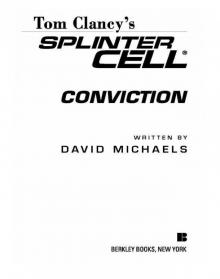 Conviction (2009)
Conviction (2009) Battle Ready
Battle Ready Patriot Games
Patriot Games The Sum of All Fears
The Sum of All Fears Fallout (2007)
Fallout (2007) Red Storm Rising
Red Storm Rising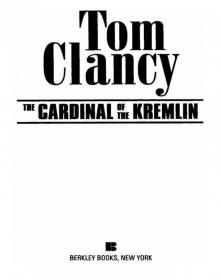 The Cardinal of the Kremlin
The Cardinal of the Kremlin Executive Orders
Executive Orders Lincoln, the unknown
Lincoln, the unknown Threat Vector
Threat Vector The Hunted
The Hunted Shadow Warriors: Inside the Special Forces
Shadow Warriors: Inside the Special Forces End Game
End Game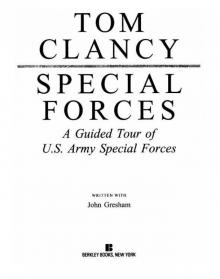 Special Forces: A Guided Tour of U.S. Army Special Forces
Special Forces: A Guided Tour of U.S. Army Special Forces Locked On
Locked On Line of Sight
Line of Sight Tom Clancy Enemy Contact - Mike Maden
Tom Clancy Enemy Contact - Mike Maden Fighter Wing: A Guided Tour of an Air Force Combat Wing
Fighter Wing: A Guided Tour of an Air Force Combat Wing Springboard
Springboard Line of Sight - Mike Maden
Line of Sight - Mike Maden EndWar
EndWar Dead or Alive
Dead or Alive Tom Clancy Support and Defend
Tom Clancy Support and Defend Checkmate
Checkmate Command Authority
Command Authority Carrier: A Guided Tour of an Aircraft Carrier
Carrier: A Guided Tour of an Aircraft Carrier Blacklist Aftermath
Blacklist Aftermath Marine: A Guided Tour of a Marine Expeditionary Unit
Marine: A Guided Tour of a Marine Expeditionary Unit Commander-In-Chief
Commander-In-Chief Armored Cav: A Guided Tour of an Armored Cavalry Regiment
Armored Cav: A Guided Tour of an Armored Cavalry Regiment Tom Clancy's Jack Ryan Books 1-6
Tom Clancy's Jack Ryan Books 1-6 The Ultimate Escape
The Ultimate Escape Airborne: A Guided Tour of an Airborne Task Force
Airborne: A Guided Tour of an Airborne Task Force Debt of Honor
Debt of Honor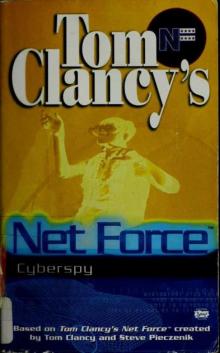 Cyberspy
Cyberspy Point of Contact
Point of Contact Operation Barracuda (2005)
Operation Barracuda (2005) Choke Point
Choke Point Power and Empire
Power and Empire Every Man a Tiger: The Gulf War Air Campaign
Every Man a Tiger: The Gulf War Air Campaign Endgame (1998)
Endgame (1998) EndWar: The Missing
EndWar: The Missing Splinter Cell (2004)
Splinter Cell (2004) The Great Race
The Great Race True Faith and Allegiance
True Faith and Allegiance Deathworld
Deathworld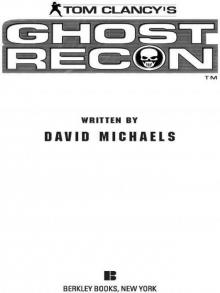 Ghost Recon (2008)
Ghost Recon (2008) Duel Identity
Duel Identity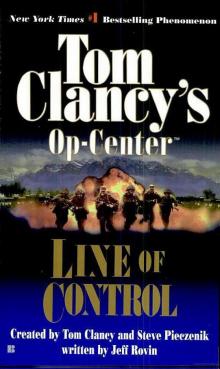 Line of Control o-8
Line of Control o-8 The Hunt for Red October jr-3
The Hunt for Red October jr-3 Hidden Agendas nf-2
Hidden Agendas nf-2 Acts of War oc-4
Acts of War oc-4 Ruthless.Com pp-2
Ruthless.Com pp-2 Night Moves
Night Moves The Hounds of Rome - Mystery of a Fugitive Priest
The Hounds of Rome - Mystery of a Fugitive Priest Into the Storm: On the Ground in Iraq sic-1
Into the Storm: On the Ground in Iraq sic-1 Threat Vector jrj-4
Threat Vector jrj-4 Combat Ops gr-2
Combat Ops gr-2 Virtual Vandals nfe-1
Virtual Vandals nfe-1 Runaways nfe-16
Runaways nfe-16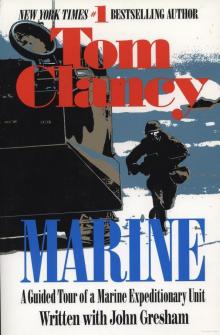 Marine: A Guided Tour of a Marine Expeditionary Unit tcml-4
Marine: A Guided Tour of a Marine Expeditionary Unit tcml-4 Shadow Warriors: Inside the Special Forces sic-3
Shadow Warriors: Inside the Special Forces sic-3 Jack Ryan Books 1-6
Jack Ryan Books 1-6 Cold Case nfe-15
Cold Case nfe-15 Changing of the Guard nf-8
Changing of the Guard nf-8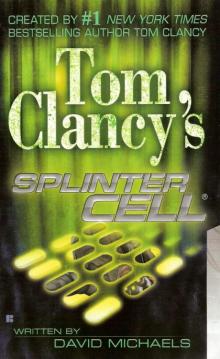 Splinter Cell sc-1
Splinter Cell sc-1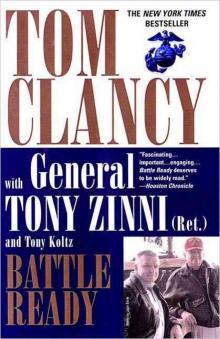 Battle Ready sic-4
Battle Ready sic-4 The Bear and the Dragon jrao-11
The Bear and the Dragon jrao-11 Fighter Wing: A Guided Tour of an Air Force Combat Wing tcml-3
Fighter Wing: A Guided Tour of an Air Force Combat Wing tcml-3 Patriot Games jr-1
Patriot Games jr-1 Jack Ryan Books 7-12
Jack Ryan Books 7-12 Mission of Honor o-9
Mission of Honor o-9 Private Lives nfe-9
Private Lives nfe-9 Operation Barracuda sc-2
Operation Barracuda sc-2 Cold War pp-5
Cold War pp-5 Point of Impact nf-5
Point of Impact nf-5 Red Rabbit jr-9
Red Rabbit jr-9 The Deadliest Game nfe-2
The Deadliest Game nfe-2 Springboard nf-9
Springboard nf-9 Safe House nfe-10
Safe House nfe-10 EndWar e-1
EndWar e-1 Duel Identity nfe-12
Duel Identity nfe-12 Deathworld nfe-13
Deathworld nfe-13 Politika pp-1
Politika pp-1 Rainbow Six jr-9
Rainbow Six jr-9 Tom Clancy's Power Plays 1 - 4
Tom Clancy's Power Plays 1 - 4 Endgame sc-6
Endgame sc-6 Executive Orders jr-7
Executive Orders jr-7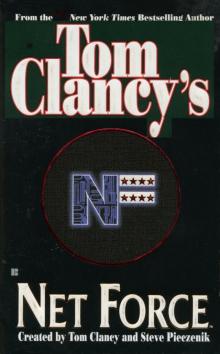 Net Force nf-1
Net Force nf-1 Call to Treason o-11
Call to Treason o-11 Locked On jrj-3
Locked On jrj-3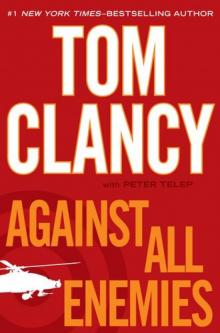 Against All Enemies
Against All Enemies The Sum of All Fears jr-7
The Sum of All Fears jr-7 Sea of Fire o-10
Sea of Fire o-10 Fallout sc-4
Fallout sc-4 Balance of Power o-5
Balance of Power o-5 Shadow Watch pp-3
Shadow Watch pp-3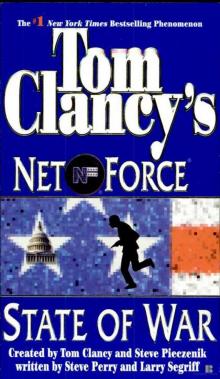 State of War nf-7
State of War nf-7 Wild Card pp-8
Wild Card pp-8 Games of State o-3
Games of State o-3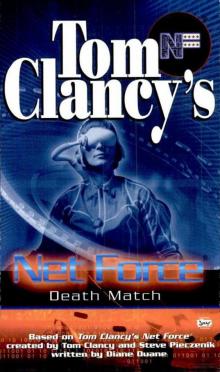 Death Match nfe-18
Death Match nfe-18 Against All Enemies mm-1
Against All Enemies mm-1 Every Man a Tiger: The Gulf War Air Campaign sic-2
Every Man a Tiger: The Gulf War Air Campaign sic-2 Cybernation nf-6
Cybernation nf-6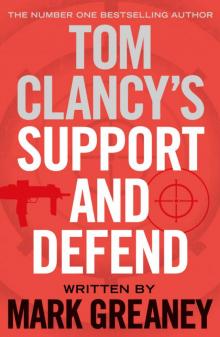 Support and Defend
Support and Defend Night Moves nf-3
Night Moves nf-3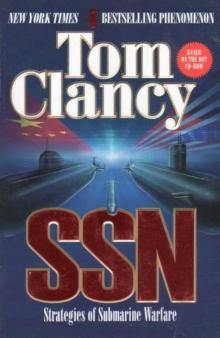 SSN
SSN Cutting Edge pp-6
Cutting Edge pp-6 The Cardinal of the Kremlin jrao-5
The Cardinal of the Kremlin jrao-5 War of Eagles o-12
War of Eagles o-12 Op-Center o-1
Op-Center o-1 Mirror Image o-2
Mirror Image o-2 The Archimedes Effect nf-10
The Archimedes Effect nf-10 Teeth of the Tiger jrj-1
Teeth of the Tiger jrj-1 Bio-Strike pp-4
Bio-Strike pp-4 State of Siege o-6
State of Siege o-6 Debt of Honor jr-6
Debt of Honor jr-6 Zero Hour pp-7
Zero Hour pp-7 Ghost Recon gr-1
Ghost Recon gr-1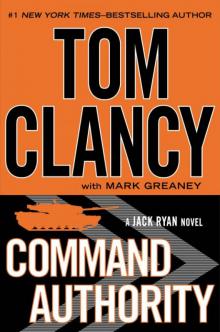 Command Authority jr-10
Command Authority jr-10 Tom Clancy's Power Plays 5 - 8
Tom Clancy's Power Plays 5 - 8 Checkmate sc-3
Checkmate sc-3 Breaking Point nf-4
Breaking Point nf-4 Gameprey nfe-11
Gameprey nfe-11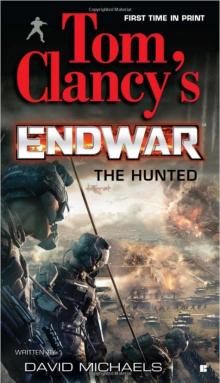 The Hunted e-2
The Hunted e-2 Hidden Agendas
Hidden Agendas Divide and Conquer o-7
Divide and Conquer o-7